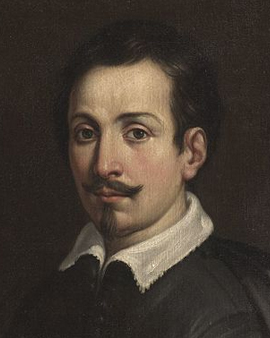


The painter Guido Reni was born in 1575 in Bologna in Italy. The baroque artist is best known for his highly decorative paintings. Reni began his artistic apprenticeship with the mannerist Denis Calvaert until he later changed to a newly established art school, which was progressive by then standards. The Carracci family, who ran the art school, had a decisive influence on Reni's art. They were primarily opposed to the mannerism represented by Reni's previous master Calvaert. They were committed to a return of the arts to the realism of the great masters of the High Renaissance. Examples of this period were Raphael, Tizian and Veronese.
Reni's private life has always been a mystery to art history: the Italian painter had the peculiarity of being terribly afraid of women. This was expressed in his fear of being poisoned by the mere touch of a woman. Some suspect that he might have been homosexual, while others describe him as ascetic. Even during Reni's lifetime, he was considered an oddity among artist colleagues because of his unusual lifestyle. His patrons saw in the discreet quality of his art a connection to different lives as a loner.
Reni loved Rome and spent many years in the great city of culture. His idol was the Roman painter Caravaggio. In the painting "Crucifixion of St. Peter" from 1603 Reni tried to imitate Caravaggio's rough way of painting deep shadows. At the same time Reni succeeded in maintaining his Bolognese Classicism through the rather formal poses of the figures and the careful symmetry of the composition. Soon, however, Reni found this balancing act between the styles to be an unpleasant compromise and began to think about a clearer form of expression, which we now associate with Baroque Classicism. Reni was very successful and replaced Annibale Carracci as master of Baroque Classicism in Rome. The so-called Aurora fresco, which Reni painted in Rome's Casino of the Pallavicini-Rospigliosi Palace, bears witness to his superiority: the crisp, Hellenistic elegance rightly earned him the leading position.
In 1614 the painter returned to his home town of Bologna, where he continued his formalism with even more accent. In his work "Atalanta and Hippomenes" the cold, impersonal nude figures seem like fragments of antique marble statues. As a mature artist he further developed his painting style. In oil paintings such as "Cleopatra and Girl with Wreath" there are no longer any elaborate poses or folds. Reni's painting becomes looser and no longer consists of lines, but rather of colours that have been applied thinly with a quick brushstroke. All shades of colour Renis backed grey, so that they often appear faded.

The painter Guido Reni was born in 1575 in Bologna in Italy. The baroque artist is best known for his highly decorative paintings. Reni began his artistic apprenticeship with the mannerist Denis Calvaert until he later changed to a newly established art school, which was progressive by then standards. The Carracci family, who ran the art school, had a decisive influence on Reni's art. They were primarily opposed to the mannerism represented by Reni's previous master Calvaert. They were committed to a return of the arts to the realism of the great masters of the High Renaissance. Examples of this period were Raphael, Tizian and Veronese.
Reni's private life has always been a mystery to art history: the Italian painter had the peculiarity of being terribly afraid of women. This was expressed in his fear of being poisoned by the mere touch of a woman. Some suspect that he might have been homosexual, while others describe him as ascetic. Even during Reni's lifetime, he was considered an oddity among artist colleagues because of his unusual lifestyle. His patrons saw in the discreet quality of his art a connection to different lives as a loner.
Reni loved Rome and spent many years in the great city of culture. His idol was the Roman painter Caravaggio. In the painting "Crucifixion of St. Peter" from 1603 Reni tried to imitate Caravaggio's rough way of painting deep shadows. At the same time Reni succeeded in maintaining his Bolognese Classicism through the rather formal poses of the figures and the careful symmetry of the composition. Soon, however, Reni found this balancing act between the styles to be an unpleasant compromise and began to think about a clearer form of expression, which we now associate with Baroque Classicism. Reni was very successful and replaced Annibale Carracci as master of Baroque Classicism in Rome. The so-called Aurora fresco, which Reni painted in Rome's Casino of the Pallavicini-Rospigliosi Palace, bears witness to his superiority: the crisp, Hellenistic elegance rightly earned him the leading position.
In 1614 the painter returned to his home town of Bologna, where he continued his formalism with even more accent. In his work "Atalanta and Hippomenes" the cold, impersonal nude figures seem like fragments of antique marble statues. As a mature artist he further developed his painting style. In oil paintings such as "Cleopatra and Girl with Wreath" there are no longer any elaborate poses or folds. Reni's painting becomes looser and no longer consists of lines, but rather of colours that have been applied thinly with a quick brushstroke. All shades of colour Renis backed grey, so that they often appear faded.
Page 1 / 5








